More about Honoré Daumier
Works by Honoré Daumier

Contributor
Honoré Daumier single handedly ruined the right of (relatively) free press in France in the 1830s.
But I’m getting ahead of myself so I’ll start from the beginning. Honoré Daumier was born in 1808 in Marseille, France. His father was an aspiring poet so in order to support himself, he put his 12 year old to work. Honoré didn’t protest. Actually it was more like he wouldn’t as he had a bad stutter and rarely spoke. Honoré did however request to work in an artistic field but that was his dad’s thing so he was forced to work in a bailiff’s office (some prime parenting skills right there). This instilled in little Honoré a compassion for the ordinary and downtrodden citizens of France not unlike himself. He quit his job a year later and began working at a bookstore where he was introduced to caricaturing.
Finally at the ripe age of 16, Daumier was allowed to attend art school and work for a lithographer named Belliard. He soon mastered lithography and landed a job at La Caricature, a journal known for berating King Louis-Philippe’s bourgey government which was wildly corrupt. This was the perfect time because, “In 1830, newly installed on the throne, King Louis-Philippe boldly declared an end to censorship laws… [beginning] a golden era in the French press.” But Daumier (aka dumb-ier) had too much of a knack for railing on the government apparently and was imprisoned for six months after depicting the King as “Gargantua,” a super fat, super ugly beast who eats the wealth of his citizens.
Soon thereafter in 1834, the censorship law was repealed but it was too late. Daumier had already won acclaim for his work and continued to be the defender of the weak via sarcastic and satirical caricature and painting. His talent was well-rounded too as Guilliaume Apollinaire later called Daumier “the Michelangelo of the lithograph.” He was a brilliant artist but he went blind in his old age, prematurely ending his artistic career leaving him in debt until the day he died.
Sources
- Genocchio, Benjamin. "A Masterful Caricaturist And His Lithographs". Nytimes.com. N.p., 2008. Web. 13 Mar. 2017.
- Schjeldahl, Peter. "Citizen Daumier". The New Yorker. N.p., 2000. Web. 13 Mar. 2017.

Featured Books & Academic Sources
The following is an excerpt from "Promenades of an Impressionist" by James Huneker, published in 1910:
Honoré Daumier, who died February 11, 1879, was almost the last of the giants of 1830, though he outlived many of them. Not affiliated with the Barbizon group—though he was a romantic in his hatred of the bourgeois—several of these painters were intimate friends; indeed, Corot was his benefactor, making him a present of a cottage at Valmondois (Seine-et-Oise), where the illustrator died. He was blind and lonely at the end. Corot died 1875; Daubigny, his companion, 1878; Millet, 1875, and Rousseau, with whom he corresponded, died 1867. In 1879 Flaubert still lived, working heroically upon that monument of human inanity, Bouvard et Pécuchet; Maupassant, his disciple, had just published a volume of verse; Manet was regarded as a dangerous charlatan, Monet looked on as a madman; while poor Cézanne was only a bad joke. The indurated critical judgment of the academic forces pronounced Bonnat a greater portraitist than Velasquez, and Gérôme and his mock antiques and mock orientalism far superior to Fromentin and Chasseriau. It was a glorious epoch for mediocrity. And Daumier, in whom there was something of Michael Angelo and Courbet, was admired only as a clever caricaturist, the significance of his paintings escaping all except a few. Corot knew, Daubigny knew, as earlier Delacroix knew; and Balzac had said: "There is something of the Michael Angelo in this man!"
Baudelaire, whose critical flair never failed him, wrote in his Curiosités Esthétiques: "Daumier's distinguishing note as an artist is his certainty. His drawing is fluent and easy; it is a continuous improvisation. His powers of observation are such that in his work we never find a single head that is out of character with the figure beneath it. … Here, in these animalised faces, may be seen and read clearly all the meannesses of soul, all the absurdities, all the aberrations of intelligence, all the vices of the heart; yet at the same time all is broadly drawn and accentuated." Nevertheless one must not look at too many of these caricatures. At first the Rabelaisian side of the man appeals; presently his bitterness becomes too acrid. Humanity is silly, repulsive; it is goat, pig, snake, monkey, and tiger; but there is something else. Daumier would see several sides. His pessimism, like Flaubert's, is deadly, but at times reaches the pitch of the heroic. He could have echoed Flaubert's famous sentence: "The ignoble is the sublime of the lower slope." Yet what wit, what humour, what humanity in Daumier! His Don Quixote and Sancho Panza are worth a wilderness of Dorés. And the Good Samaritan or The Drinkers. The latter is as jovial as Steen or Hals.
A story went the rounds after his death which neatly illustrates his lack of worldliness. His modesty was proverbial, and once Daubigny, on introducing him to an American picture dealer, warned him not to ask less than five thousand francs for the first picture he sold to the man. The American went to Daumier's atelier, and seeing a picture on the easel, asked, "How much?" The artist, remembering Daubigny's warning, answered, "Five thousand francs." The dealer immediately bought it, and on demanding to see something else, Daumier put another canvas on the easel, far superior to the one sold. The Yankee again asked the price. The poor artist was perplexed. He had received no instructions from Daubigny regarding a second sale; so when the question was repeated he hesitated, and his timidity getting the better of him, he replied: "Five hundred francs." "Don't want it; wouldn't take it as a gift," said the dealer. "I like the other better. Besides, I never sell any but expensive pictures," and he went away satisfied that a man who sold so cheaply was not much of an artist. This anecdote, which we heard second hand from Daubigny, may be a fable, yet it never failed to send Daubigny into fits of laughter. It may be surmised that, despite his herculean labours, extending over more than half a century, Daumier never knew how to make or save money.
He was born at Marseilles in 1808. His father was a third-rate poet who, suspecting his own gift, doubted the talent of his son, though this talent was both precocious and prodigious. The usual thing happened. Daumier would stick at nothing but his drawing; the attempt to force him into law studies only made him hate the law and lawyers and that hatred he never ceased to vent in his caricatures. He knocked about until he learned in 1829 the technics of lithography; then he soon became self-supporting. His progress was rapid. He illustrated for the Boulevard journals; he caricatured Louis Philippe and was sent to jail, Sainte-Pélagie, for six months. Many years afterward he attacked with a like ferocity Napoleon III.
Look at his frontispiece—rather an advertisement—of Victor Hugo's Les Châtiments. It is as sinister, as malign as a Rops. The big book, title displayed, crushes to earth a vulture which is a travesty of the Napoleonic beak. Daumier was a power in Paris. Albert Wolff, the critic of Figaro, tells how he earned five francs each time he provided a text for a caricature by Daumier, and Philipon, who founded several journals, actually claimed a share in Daumier's success because he wrote some of the silly dialogues to his plates.
Daumier was the artistic progenitor of the Caran d'Aches, the Forains—who was it that called Forain "Degas en caricature"?—Willettes, and Toulouse-de-Lautrecs. He was a political pamphleteer, a scourger of public scamps, and a pictorial muck-raker of genius. His mockery of the classic in art was later paralleled by Offenbach in "La Belle Hélène." But there were other sides to his genius. Tiring of the hurly-burly of journalism, he retired in 1860 to devote himself to painting.
His style has been pronounced akin to that of Eugène Carrière; his sense of values on a par with Goya's and Rembrandt's (that Shop Window of his in the Durand-Ruel collection is truly Rembrandtesque). This feeling for values was so remarkable that it enabled him to produce an impression with three or four tones. The colours he preferred were grays, browns, and he manipulated his blacks like a master. Mauclair does not hesitate to put Daumier among the great painters of the past century on the score of his small canvases. "They contain all his gifts of bitter and profound observation, all the mastery of his drawings, to which they add the attractions of rich and intense colour," declares Mauclair. Doubtless he was affected by the influence of Henri Monnier, but Daumier really comes from no one. He belongs to the fierce tribe of synics and men of exuberant powers, like Goya and Courbet. A born anarch of art, he submitted to no yoke. He would have said with Anacharsis Cloots: "I belong to the party of indignation." He was a proud individualist. That he had a tender side, a talent for friendship, may be noted in the affectionate intercourse he maintained for years with Corot, Millet, Rousseau, Dupré, Geoffroy, the sculptor Pascal, and others. He was very impulsive and had a good heart with all his misanthropy, for he was an idealist reversed. The etching of him by Loys Delteil is thus described by a sympathetic commentator: "Daumier was very broad-shouldered, his head rather big, with slightly sunken eyes, which must, however, have had an extraordinary power of penetration. Though the nose is a little heavy and inelegant, the projecting forehead, unusually massive like that of Victor Hugo or of Beethoven and barred with a determined furrow, reveals the great thinker, the man of lofty and noble aspirations. The rather long hair, thrown backward, adds to the expression of the fine head; and finally the beard worn collarwise, according to the prevailing fashion, gives to Daumier's face the distinctive mark of his period." This etched portrait may be seen in several states at the Lenox Library.
Sources
- Huneker, James. Promenades of an Impressionist. New York: Charles Scriber's Sons, 1910.
Featured Content
Here is what Wikipedia says about Honoré Daumier
Honoré-Victorin Daumier (
French: [ɔnɔʁe domje]; February 26, 1808 – February 10 or 11, 1879) was a French painter, sculptor, and printmaker, whose many works offer commentary on the social and political life in France, from the Revolution of 1830 to the fall of the Second French Empire in 1870. He earned a living producing caricatures and cartoons in newspapers and periodicals such as La Caricature and Le Charivari, for which he became well known in his lifetime and is still remembered today. He was a republican democrat (working class liberal), who satirized and lampooned the monarchy, aristocracy, clergy, politicians, the judiciary, lawyers, police, detectives, the wealthy, the military, the bourgeoisie, as well as his countrymen and human nature in general.
Daumier was a serious painter, loosely associated with realism, sometimes blurring the boundaries between caricature and fine art. Although he occasionally exhibited at the Parisian Salon, his paintings were largely overlooked and ignored by the French public and critics of the day. Yet Daumier's fellow painters, as well as the poet and art critic Charles Baudelaire, noticed and greatly admired his work. Later generations would recognize Daumier as one of the great French artists of the 19th century, profoundly influencing a younger generation of impressionist and postimpressionist painters. Daumier was a tireless and prolific artist and produced more than 100 sculptures, 500 paintings, 1,000 drawings, 1,000 wood engravings, and 4,000 lithographs.
Daumier came from a poor family and was working by the age of 12, first at a huissier de justice, then at a bookstore frequented by artists where he began to draw. He received some mentorship from Alexandre Lenoir, attended the Académie Suisse, learned lithography, and was producing advertisements, illustrations, and caricatures by the time he was twenty. After the July Revolution of 1830 he begin working for satirical political papers that were highly critical of the new monarch Louis Philippe I and his court. He was jailed for several months in 1832 after the publication of Gargantua, a particularly offensive depiction of the King, Louis Philippe. After his release Daumier resumed publishing political lithographs until the September Laws were passed in 1835, limiting the freedom of the press. Afterwards, his cartoons softened, the bourgeoisie and daily Parisian life were more frequent subjects, and when political subjects did appear they were oblique and veiled. Daumier experienced financial hardships and debt throughout much of his life.
Daumier married Alexandrine Dassy in 1846 and moved to the Île Saint-Louis where they lived until 1863. He increasingly associated with writers, poets, painters, and sculptors there, including Baudelaire, Corot, Courbet, Delacroix among others, and began to paint in earnest. He spent his summers from 1853 onward in Barbizon and Valmondois, where artists of the Barbizon school and realist movement worked. As his desire to paint intensified, his enthusiasm for cartooning declined, as did his popularity with the public. Le Charivari stopped publishing his comics in 1860. A period of financial hardship followed, and from 1863–1865 he moved to a series of lodgings around Montmartre and lost contact with many friends. Le Charivari gave him a new contract in 1864 and he resumed making caricatures for an appreciative audience in Paris. Daumier moved to Valmondois in 1865. He experienced failing eyesight and poverty there, although he continued to produce lithographs and paint, often on the theme of Don Quixote. The French Third Republic granted him a pension in 1877, and the following year a major exhibition of his paintings was held in Paris, which received significant recognition in the final months of his life. Daumier died in February 1879. Various sources give conflicting dates regarding the day of his death: some state February 10, 1879, others February 11.
Check out the full Wikipedia article about Honoré Daumier

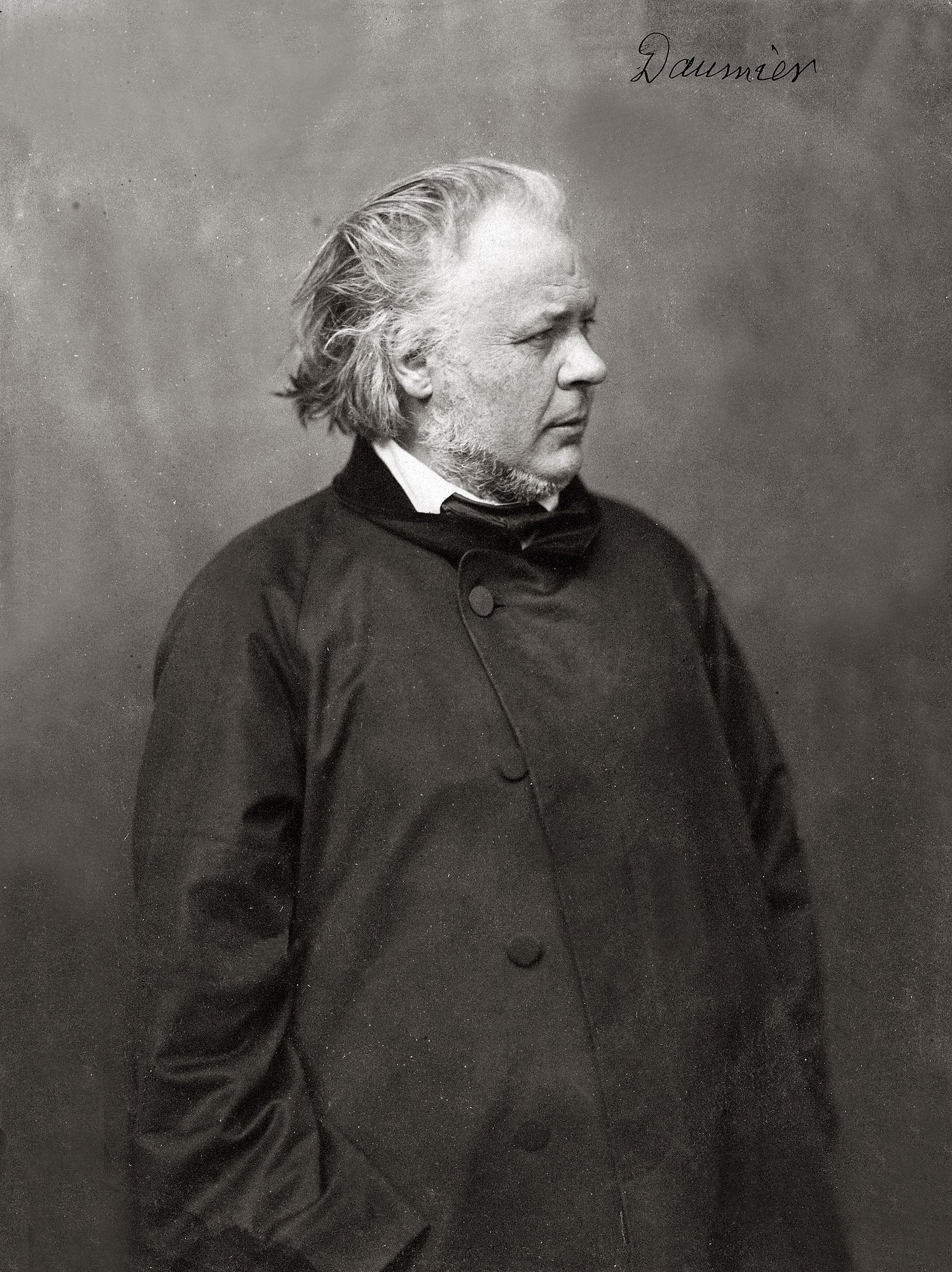
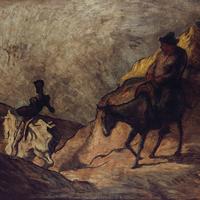
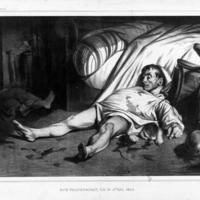
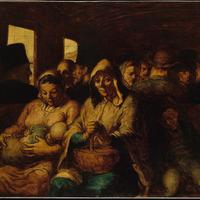









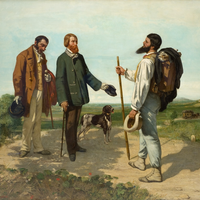
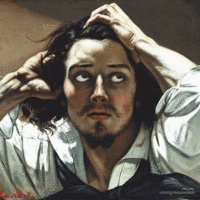
Maybe someone can explain to me why a parent would call their child Honoré. I get that he was French, but what is wrong with Jean-Pierre, Jean-Claude, or any of a number of other Jean- combinations? To me Honoré just sounds weirdly pompous. Maybe Jean-pamplemouse? No that does not work either.